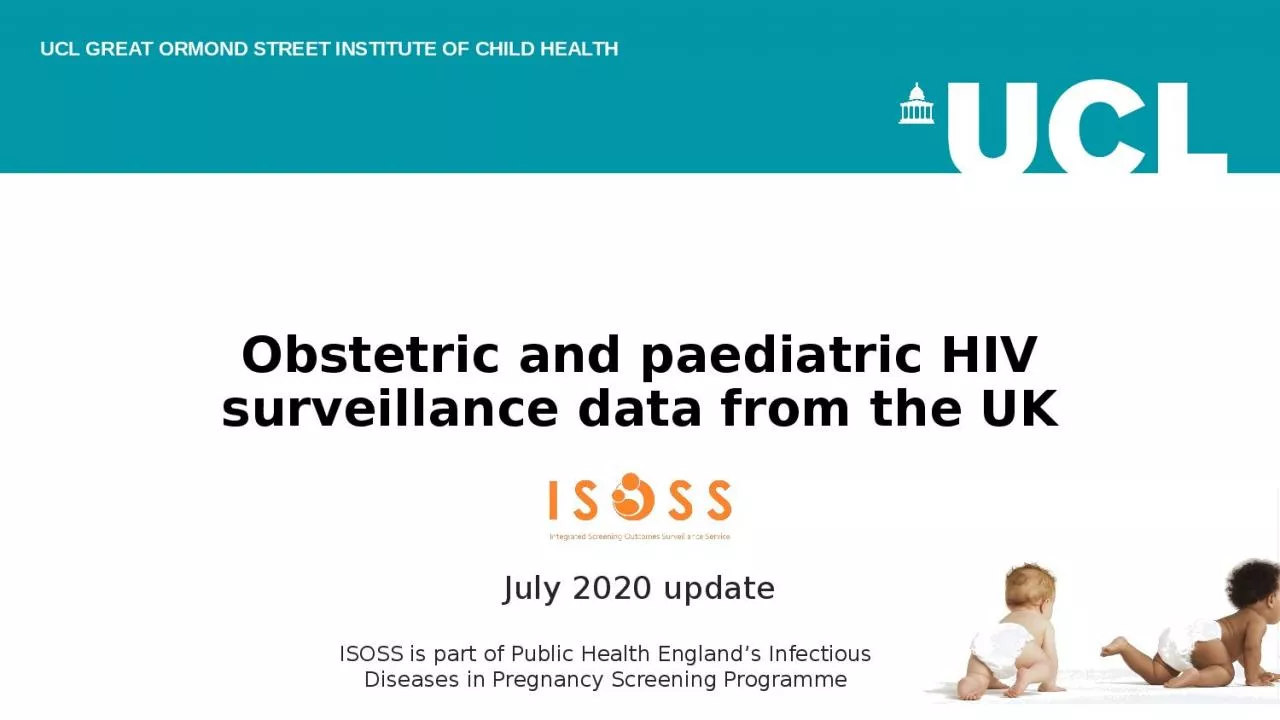

Obstetric and paediatric HIV surveillance data from the UK ISOSS is part of Public Health Englands Infectious Diseases in Pregnancy Screening Programme July 2020 update Integrated Screening Outcomes Surveillance Service HIV surveillance ID: 931921
Download Presentation The PPT/PDF document "UCL GREAT ORMOND STREET INSTITUTE OF CHI..." is the property of its rightful owner. Permission is granted to download and print the materials on this web site for personal, non-commercial use only, and to display it on your personal computer provided you do not modify the materials and that you retain all copyright notices contained in the materials. By downloading content from our website, you accept the terms of this agreement.
Slide1
UCL GREAT ORMOND STREET INSTITUTE OF CHILD HEALTH
Obstetric and paediatric HIV surveillance data from the UK
ISOSS is part of Public Health England’s Infectious Diseases in Pregnancy Screening Programme
July 2020 update
Slide2Integrated Screening Outcomes Surveillance Service – HIV surveillance
Comprehensive observational surveillance
of obstetric and paediatric HIV in the UK
building on the long-running National
Surveillance of HIV in Pregnancy and Childhood (NSHPC), in place since 1990
Maternity
reports of all pregnancies in women
living with HIV through maternity units; demographics, pregnancy management, outcome Paediatric reports of all HIV-exposed infants and diagnosed children (<16 years) through clinics; confirmation of infection status; ongoing follow-up of diagnosed children through CHIPS Patient data is collected without consent by ISOSS with PHE Regulation 3 approvalEnhanced surveillance of: - cases of supported breastfeeding - all UK-born vertical transmissions
Slide3Pregnancies in women with diagnosed HIV, 1990 to date (UK)
Source: pregnancies
since 1990
reported
to the
ISOSS by
June 2020
23,733 pregnancies
in diagnosed women since 1990
Slide4Pregnancy outcomes, 1990 to date (UK)
Source: pregnancies
since 1990
reported
to ISOSS by
June 2020
Slide5M
aternal demographics, early 2000s and now
(UK)
2000-04
62.5%
33.8%
2.8%
1.0%
2015-
37.4%
56.8%
3.2%
2.7%
Country/region of report
London
Rest of England
Scotland
Wales / N. Ireland
Median
age
(years)
IDU-acquired HIV
Perinatal
HIV
African-born
Eastern
Europe*-born
29
2.6%
0.03%
77.2%0.3%
341.0%2.8%66.4%6.3%
Source: pregnancies since 1990 reported through ISOSS maternity scheme by June 2020
* includes the Baltic states (Estonia, Latvia, Lithuania)
Slide6Timing of maternal HIV diagnosis, UK 1998-2019
UK pregnancies (all outcomes) reported to
ISOSS
by
June 2020*
* includes data from all
ISOSS
reporting sources; excludes 139 pregnancies missing timing of diagnosis** reporting delay for recent yearsNumber of pregnancies89% of pregnancies since 2015 have been in women diagnosed pre-conception
Slide7Timing of diagnosis & ART at conception, UK 1998-2019
* contains pregnancies
lacking
information
on
precise timing of
diagnosis and/or ART use** reporting delay for recent yearsUK pregnancies (all outcomes) reported to ISOSS by June 2020~76% of pregnancies since 2015 have been conceived on antiretroviral therapyNumber of pregnancies
Slide8Shifts in mode of delivery among diagnosed women, UK 2000-2019
Proportion of deliveries
UK deliveries reported to
ISOSS
by
June
2020
*
* reporting delay for recent years
Slide9Children living with HIV, UK 1986 to date
Transition
to adult care, life-long ART and HIV
Annual data on infected children and adolescents
* excludes 267 children with haemophilia
reported through a separate scheme
Slide10Infection status of children born to diagnosed women
Number of children
* incomplete
due to
reporting
delay
UK births reported to ISOSS by June 2020
Slide11Vertical transmission in UK/Ireland, 2000-2016
Data
for
2000-11 from Townsend
et al. AIDS 2014;
data for
2012-14 from Peters
et al
. CID 2016; data for 2015-16 from Peters et al. HIV Drug Therapy Glasgow 2018
Slide12Perinatal HIV transmission audit: UK births 2006-2013
62% of transmissions were in infants born to women
undiagnosed
by time of delivery
108
infants
diagnosed
with HIV infection
and reported to ISOSS by April 2014** 25 further cases reported since April 2014
Slide13Recent
publications
For a full list of publications,
visit
www.ucl.ac.uk/isoss/publications
.
Slide14Pregnancies in women with perinatal HIV (PHIV)
pregnancy incidence rate among women with PHIV
13 per 1000 woman-years
Women with PHIV were
3x more likely to have
detectable
viral load
near
delivery[OR 3.22 (CI 1.22-8.48)]Of 630 women reported to ISOSS in childhood, 45 (7%) had at least one pregnancy reportedPregnancy incidence rate lower in PHIV than in women of similar age in general UK population70 pregnancies among 45 women with PHIV were compared with 184 pregnancies among 118 age-matched women with behaviourally-acquired HIV (BHIV)
For a link to full publication, visit www.ucl.ac.uk/isoss/publications
.
Maternal and pregnancy characteristics, PHIV vs. BHIV (data source: Byrne
et al
. 2017 AIDS)
Slide15C
ongenital anomalies & exposure to
raltegravir
or elvitegravir, 2010-2018
No
reported congenital
abnormalities among 31
live-born infants exposed to
EVG-based regimensTiming of first RAL exposureN(%)Infants with anomalyPrevalence of anomaliesAt conception222(25.0%)5
2.25% (95% CI 0.73, 5.17)1st
trimester
40
(4.5%)
0
-
2
nd
/3
rd
trimester
602
(67.9%)
17
2.82% (95% CI 1.65,
4.48
)
Timing
unknown22(13.5%)1-Overall886 232.59% (95% CI 1.65, 3.86)Consistent with national population estimates for time period in the UK and historic prevalence in NSHPCNo apparent clustering of specific anomalies; no reported neural tube defectsPrevalence of congenital anomalies among raltegravir-exposed infants by timing of first exposure (data source: Rasi et al. 2018 JAIDS)
23 reported congenital anomalies among 886 live-born infants exposed to RAL-based regimens
overall prevalence of congenital anomalies among RAL-exposed infants2.59% (95% CI 1.65, 3.86)For a link to full publication, visit www.ucl.ac.uk/isoss/publications.
Slide16Patient
data
are
collected under legal permissions granted to PHE under Regulation 3 of The Health Service (Control of Patient Information) Regulations 2002 (see
www.ucl.ac.uk/isoss/governance)
Funding:
Public Health England
NHS Infectious Diseases in Pregnancy Screening Programme
Visit the Integrated Screening Outcomes Surveillance Service (ISOSS) websites at www.ucl.ac.uk/isoss and GOV.UKISOSS Team:
Surveillance Lead: Claire Thorne
Surveillance Manager:
Helen Peters
Surveillance Coordinator:
Kate Francis
Surveillance Assistants:
Laurette Bukasa, Rebecca Sconza
Surveillance Administrator:
Corinne
Hill
Acknowledgements
All
ISOSS
respondents
Public Health
England’s Infectious Diseases in Pregnancy Screening Programme
Contributors to the
Collaborative HIV Paediatric Study (CHIPS) at the MRC Clinical Trials Unit and the clinical centres